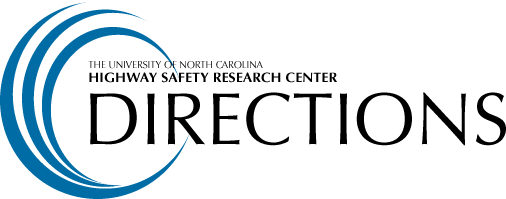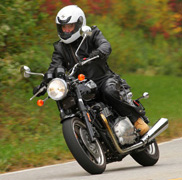

North Carolina's motorcycle helmet requirement: Saving lives, reducing injuries

Motorcycle crashes have been increasing in North Carolina – in 2010, there were 4,240 crashes involving motorcyclists in North Carolina, up from 2,541 crashes in 2001. Although crashes have increased, the proportion of riders who die when they crash has remained the same, largely because virtually all riders in North Carolina wear helmets. Researchers Rob Foss, Bevan Kirley and Arthur Goodwin collaborate on motorcycle research at the UNC Highway Safety Research Center (HSRC) and answered our top questions.
Q. How effective are helmets in reducing motorcycle crash fatalities and injuries?
A. Motorcycle helmets are very effective in reducing injuries and fatalities. According to the Centers for Disease Control (CDC), helmets reduce the likelihood of death in a motorcycle crash by 37 percent, and reduce the likelihood of head injury by 69 percent. That’s a big deal, especially when considering that hospital charges are 13 times higher for crash-involved motorcyclists who have a traumatic brain injury compared to those who don’t.
Q. Do most states require motorcyclists to wear helmets?
A. Right now, 19 U.S. states have universal helmet laws. These laws require every motorcycle rider and passenger to wear a helmet, every time they ride, regardless of age. Twenty-eight states have partial helmet laws covering only riders of certain ages, usually the youngest riders. Three states do not have a motorcycle helmet law. North Carolina has had a universal law in place since 1968. If we can toot our own horn, a recent CDC report found that North Carolina was number one in the nation for both lives saved and economic costs saved by motorcycle helmet use.
Q. Are helmet laws effective when they only apply to young riders?
A. No, they’re not. Research has shown there is a 37 percent increase in risk of traumatic brain injury among young riders in states with partial helmet laws compared to states with universal coverage. Additionally, CDC looked at fatal motorcycle crashes from 2008 to 2010. In states with universal helmet laws, only 12 percent of fatally injured motorcyclists were not wearing helmets. By comparison, 64 percent of riders were not wearing helmets in states with partial helmet laws, and 79 percent of riders were not wearing helmets in states without helmet laws.
Q. Does helmet use change when a state passes a universal helmet law?
A. The research on that one is clear. When a state moves to a universal helmet law, we see big increases in helmet use among motorcycle riders. For example, when Nebraska passed their universal helmet law, helmet use increased from 15 percent before the law to 85 percent afterward. Other states such as California, Louisiana, Maryland and Washington also saw large increases in helmet use after enacting a universal helmet use requirement.
Q. What about the opposite? What happens when a state repeals its universal helmet law?
A. Then we see the reverse pattern. Florida is a good example. Motorcyclist helmet use in Florida was 99 percent when the state had a universal helmet law. After they moved to a partial helmet law, helmet use dropped to 53 percent. Not surprisingly, there was a 55 percent increase in motorcycle rider deaths after the helmet law was repealed, and the costs of treating head injuries from motorcycle crashes more than doubled. Motorcycle fatalities even went up among riders under the age of 21 who were still covered by the law.
Q. Do motorcycle riders support universal helmet laws?
A. Yes. We looked at approval of North Carolina’s helmet law in a 2012 telephone survey of 600 residents. Among respondents who had ridden a motorcycle during the past year, 78 percent support the helmet requirement. Among non-motorcyclists, nearly all – 93 percent – favor the requirement.
Q. What else can be done, in addition to requiring helmet use, to keep motorcyclists safe?
A. Right now, helmets are the only proven way to improve motorcycle safety. A number of other efforts have been tried such as training for new or experienced riders, programs to make drivers more aware of motorcyclists, and anti-drinking and riding campaigns. There is no evidence that any of these efforts reduce motorcycle crashes or deaths.
Q. What motorcycle safety issues are you currently researching?
A. We recently completed a study looking at motorcycle crashes in the western part of North Carolina. That part of the state is mountainous, and it’s a popular destination for motorcycle riders given the many two-lane winding roads and beautiful scenery. We examined the motorcycle crash rate on some of the most popular roads among the motorcycling community, and compared them to other similar roads that aren’t as well known. We also conducted interviews with more than a hundred motorcyclists and carried out observations of several thousand others. We found that certain roads are more dangerous than might be expected, that inexperience riding in mountainous terrain may be a problem, and that this will be a difficult issue to address because so many riders in the North Carolina mountains come from other states. On the bright side, it’s worth noting that 100 percent of the motorcyclists we observed during the study period were wearing a helmet.
The University of North Carolina Highway Safety Research Center
730 Martin Luther King Jr. Blvd, Suite 300 | Campus Box 3430 | Chapel Hill, NC 27599-3430
Phone: 919.962.2203 | Fax: 919.962.8710
http://www.hsrc.unc.edu